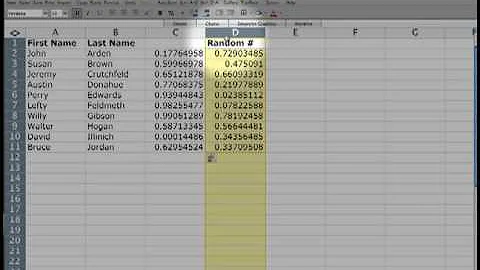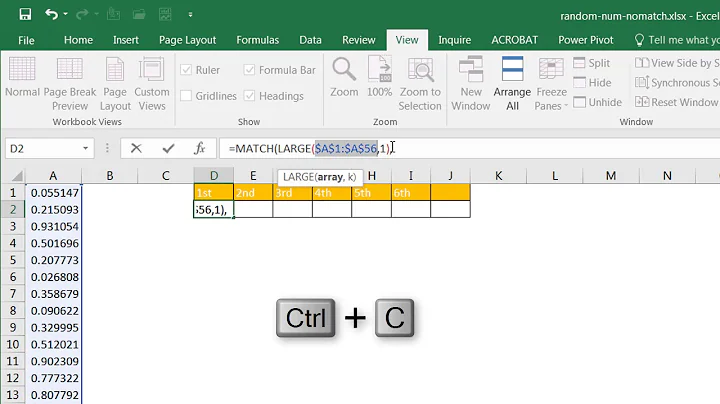Random is barely random at all?
Solution 1
The Birthday Paradox, or why PRNGs produce duplicates more often than you might think.
There are a couple of issues at play in the OP's problem. One is the birthday paradox as mentioned above and the second is the nature of what you are generating, which does not inherently guarantee that a given number will not be repeated.
The Birthday Paradox applies where given value can occur more than once during the period of the generator - and therefore duplicates can happen within a sample of values. The effect of the Birthday Paradox is that the real likelihood of getting such duplicates is quite significant and the average period between them is smaller than one might otherwise have thought. This dissonance between the perceived and actual probabilities makes the Birthday Paradox a good example of a cognitive bias, where a naive intuitive estimate is likely to be wildly wrong.
A quick primer on Pseudo Random Number Generators (PRNGs)
The first part of your problem is that you are taking the exposed value of a random number generator and converting it to a much smaller number, so the space of possible values is reduced. Although some pseudo-random number generators do not repeat values during their period this transformation changes the domain to a much smaller one. The smaller domain invalidates the 'no repeats' condition so you can expect a significant likelihood of repeats.
Some algorithms, such as the linear congruential PRNG (A'=AX|M) do guarantee uniqueness for the entire period. In an LCG the generated value contains the entire state of the accumulator and no additional state is held. The generator is deterministic and cannot repeat a number within the period - any given accumulator value can imply only one possible successive value. Therefore, each value can only occur once within the period of the generator. However, the period of such a PRNG is relatively small - about 2^30 for typical implementations of the LCG algorithm - and cannot possibly be larger than the number of distinct values.
Not all PRNG algorithms share this characteristic; some can repeat a given value within the period. In the OP's problem, the Mersenne Twister algorithm (used in Python's random module) has a very long period - much greater than 2^32. Unlike a Linear Congruential PRNG, the result is not purely a function of the previous output value as the accumulator contains additional state. With 32-bit integer output and a period of ~2^19937, it cannot possibly provide a such a guarantee.
The Mersenne Twister is a popular algorithm for PRNGs because it has good statistical and geometric properties and a very long period - desirable characteristics for a PRNG used on simulation models.
Good statistical properties mean that the numbers generated by the algorithm are evenly distributed with no numbers having a significantly higher probability of appearing than others. Poor statistical properties could produce unwanted skew in the results.
Good geometric properies mean that sets of N numbers do not lie on a hyperplane in N-dimensional space. Poor geometric properties can generate spurious correlations in a simulation model and distort the results.
A long period means that you can generate a lot of numbers before the sequence wraps around to the start. If a model needs a large number of iterations or has to be run from several seeds then the 2^30 or so discrete numbers available from a typical LCG implementation may not be sufficient. The MT19337 algorithm has a very long period - 2^19337-1, or about 10^5821. By comparison, the total number of atoms in the universe is estimated at about 10^80.
The 32-bit integer produced by an MT19337 PRNG cannot possibly represent enough discrete values to avoid repeating during such a large period. In this case, duplicate values are likely to occur and inevitable with a large enough sample.
The Birthday Paradox in a nutshell
This problem is originally defined as the probability of any two people in the room sharing the same birthday. The key point is that any two people in the room could share a birthday. People tend to naively misinterpret the problem as the probability of someone in the room sharing a birthday with a specific individual, which is the source of the cognitive bias that often causes people to underestimate the probability. This is the incorrect assumption - there is no requirement for the match to be to a specific individual and any two individuals could match.

The probability of a match occurring between any two individuals is much higher than the probability of a match to a specific individual as the match does not have to be to a specific date. Rather, you only have to find two individuals that share the same birthday. From this graph (which can be found on the Wikipedia page on the subject), we can see that we only need 23 people in the room for there to be a 50% chance of finding two that match in this way.
From the Wikipedia entry on the subject we can get a nice summary. In the OP's problem, we have 4,500 possible 'birthdays', rather than 365. For a given number of random values generated (equating to 'people') we want to know the probability of any two identical values appearing within the sequence.
Computing the likely effect of the Birthday Paradox on the OP's problem
For a sequence of 100 numbers, we have  pairs (see Understanding the Problem) that could potentially match (i.e. the first could match with the second, third etc., the second could match the third, fourth etc. and so on), so the number of combinations that could potentially match is rather more than just 100.
pairs (see Understanding the Problem) that could potentially match (i.e. the first could match with the second, third etc., the second could match the third, fourth etc. and so on), so the number of combinations that could potentially match is rather more than just 100.
From Calculating the Probability we get an expression of  . The following snippet of Python code below does a naive evaluation of the probability of a matching pair occurring.
. The following snippet of Python code below does a naive evaluation of the probability of a matching pair occurring.
# === birthday.py ===========================================
#
from math import log10, factorial
PV=4500 # Number of possible values
SS=100 # Sample size
# These intermediate results are exceedingly large numbers;
# Python automatically starts using bignums behind the scenes.
#
numerator = factorial (PV)
denominator = (PV ** SS) * factorial (PV - SS)
# Now we need to get from bignums to floats without intermediate
# values too large to cast into a double. Taking the logs and
# subtracting them is equivalent to division.
#
log_prob_no_pair = log10 (numerator) - log10 (denominator)
# We've just calculated the log of the probability that *NO*
# two matching pairs occur in the sample. The probability
# of at least one collision is 1.0 - the probability that no
# matching pairs exist.
#
print 1.0 - (10 ** log_prob_no_pair)
This produces a sensible looking result of p=0.669 for a match occurring within 100 numbers sampled from a population of 4500 possible values. (Maybe someone could verify this and post a comment if it's wrong). From this we can see that the lengths of runs between matching numbers observed by the OP seem to be quite reasonable.
Footnote: using shuffling to get a unique sequence of pseudo-random numbers
See this answer below from S. Mark for a means of getting a guaranteed unique set of random numbers. The technique the poster refers to takes an array of numbers (which you supply, so you can make them unique) and shuffles them into a random order. Drawing the numbers in sequence from the shuffled array will give you a sequence of pseudo-random numbers that are guaranteed not to repeat.
Footnote: Cryptographically Secure PRNGs
The MT algorithm is not cryptographically secure as it is relatively easy to infer the internal state of the generator by observing a sequence of numbers. Other algorithms such as Blum Blum Shub are used for cryptographic applications but may be unsuitable for simulation or general random number applications. Cryptographically secure PRNGs may be expensive (perhaps requiring bignum calculations) or may not have good geometric properties. In the case of this type of algorithm, the primary requirement is that it should be computationally infeasible to infer the internal state of the generator by observing a sequence of values.
Solution 2
Before blaming Python, you should really brush up some probability & statistics theory. Start by reading about the birthday paradox
By the way, the random module in Python uses the Mersenne twister PRNG, which is considered very good, has an enormous period and was extensively tested. So rest assured you're in good hands.
Solution 3
As an answer to the answer of Nimbuz:

Solution 4
If you don't want repetative one, generate sequential array and use random.shuffle
Solution 5
True randomness definitely includes repetition of values before the whole set of possible values is exhausted. It would not be random otherwise, as you would be able to predict for how long a value would not be repeated.
If you ever rolled dice, you surely got 3 sixes in row quite often...
Related videos on Youtube
orokusaki
I'm Michael Angeletti. I am a Python / Django developer, specializing in SaaS applications.
Updated on July 05, 2022Comments
-
 orokusaki almost 2 years
orokusaki almost 2 yearsI did this to test the randomness of randint:
>>> from random import randint >>> >>> uniques = [] >>> for i in range(4500): # You can see I was optimistic. ... x = randint(500, 5000) ... if x in uniques: ... raise Exception('We duped %d at iteration number %d' % (x, i)) ... uniques.append(x) ... Traceback (most recent call last): File "<stdin>", line 4, in <module> Exception: We duped 887 at iteration number 7I tried about 10 times more and the best result I got was 121 iterations before a repeater. Is this the best sort of result you can get from the standard library?
-
Dyno Fu over 14 yearsif you want something truly uniq, why not try uuid module? docs.python.org/library/uuid.html
-
bayer over 14 yearsBecause that's not truly unique. Just very probably.
-
 Admin over 14 years"The Pragmatic Programmer", rule 26. "select" Isn't Broken. It is rare to find a bug in the OS or the compiler, or even a third-party product or library. The bug is most likely in the application. Or in this case, the application of probability theory.
Admin over 14 years"The Pragmatic Programmer", rule 26. "select" Isn't Broken. It is rare to find a bug in the OS or the compiler, or even a third-party product or library. The bug is most likely in the application. Or in this case, the application of probability theory. -
SilentGhost over 14 years
-
Bruno Feroleto over 14 yearsJust nitpicking: uniques = set() and uniques.add(x) would be more appropriate (efficient).
-
 orokusaki over 14 years@EOL Thanks. I love that kind of stuff. I'm new enough to programming that I absolutely don't consider that nitpicking.
orokusaki over 14 years@EOL Thanks. I love that kind of stuff. I'm new enough to programming that I absolutely don't consider that nitpicking. -
 orokusaki over 14 years@ Dyno Fu Very nice! I tried 50,000 and it never repeated.
orokusaki over 14 years@ Dyno Fu Very nice! I tried 50,000 and it never repeated. -
 ConcernedOfTunbridgeWells over 14 yearsOne of the key properties of the birthday paradox is that it's counter-intuitive. Unless you are aware of it or have some background in probability theory then you would not necessarily have any reason to do a keyword search for it. One of the USP's of Q&A sites is that you can ask a question in terms that would never actually match answers to the question if you did a pure keyword search without knowing what to search for.
ConcernedOfTunbridgeWells over 14 yearsOne of the key properties of the birthday paradox is that it's counter-intuitive. Unless you are aware of it or have some background in probability theory then you would not necessarily have any reason to do a keyword search for it. One of the USP's of Q&A sites is that you can ask a question in terms that would never actually match answers to the question if you did a pure keyword search without knowing what to search for. -
 orokusaki over 14 years@ConcernedOfTunbridgeWells I haven't studied probability, but I will say that the random.randint(500, 5000) has much better odds of a repeater than pulling a certain card twice in a row from a 4500 card deck after shuffling. It would take you 346 times on average of pulling 2 cards 13 times in a row (shuffling each time) to get a single repeater. It took me 8 tries to get it to happen twice. I don't have to study probability to see the obvious here. (no disrespect intended. I know probability theory is very complex, I just can't help but question this library and it's algorithms.)
orokusaki over 14 years@ConcernedOfTunbridgeWells I haven't studied probability, but I will say that the random.randint(500, 5000) has much better odds of a repeater than pulling a certain card twice in a row from a 4500 card deck after shuffling. It would take you 346 times on average of pulling 2 cards 13 times in a row (shuffling each time) to get a single repeater. It took me 8 tries to get it to happen twice. I don't have to study probability to see the obvious here. (no disrespect intended. I know probability theory is very complex, I just can't help but question this library and it's algorithms.) -
 BlueRaja - Danny Pflughoeft over 14 years@okoku: (regarding your reply to ConcernedOfTunbridge): what you are talking about is a completely different problem. One is the probability of getting the same card twice in a row; the other is the probability of getting ANY of the previous N-1 cards after N picks. The average number of cards from a perfect RNG for the second problem should be about 67; considering you got anywhere from 8 to 121, that sounds about right.
BlueRaja - Danny Pflughoeft over 14 years@okoku: (regarding your reply to ConcernedOfTunbridge): what you are talking about is a completely different problem. One is the probability of getting the same card twice in a row; the other is the probability of getting ANY of the previous N-1 cards after N picks. The average number of cards from a perfect RNG for the second problem should be about 67; considering you got anywhere from 8 to 121, that sounds about right. -
 Admin over 14 yearsyou are confusing Random with Evenly Distributed. It is perfectly valid for a random generator to return the exact same value over and over numerous times. If you want an Evenly Distributed Random number generator that is a completely different problem, it is a shuffling problem not a generator problem.
Admin over 14 yearsyou are confusing Random with Evenly Distributed. It is perfectly valid for a random generator to return the exact same value over and over numerous times. If you want an Evenly Distributed Random number generator that is a completely different problem, it is a shuffling problem not a generator problem. -
 orokusaki over 14 years@BlueRaja I've always considered myself very math smart and pragmatic about analyzing math related problems but probability I just don't get.
orokusaki over 14 years@BlueRaja I've always considered myself very math smart and pragmatic about analyzing math related problems but probability I just don't get. -
 orokusaki over 14 years@fuzzy lollipop. That makes sense. I didn't really look at it that way.
orokusaki over 14 years@fuzzy lollipop. That makes sense. I didn't really look at it that way. -
 ConcernedOfTunbridgeWells over 14 years@orokusaki - What makes this a good question is that you would be quite unlikely to find an answer by searching on the web unless you knew specifically to search for 'birthday paradox'.
ConcernedOfTunbridgeWells over 14 years@orokusaki - What makes this a good question is that you would be quite unlikely to find an answer by searching on the web unless you knew specifically to search for 'birthday paradox'.
-
-
jcdyer over 14 yearsYour math is incorrect because of the birthday problem. See other answers. After 45 inserts, you have a 1% chance of having repeated the first insert, but you also have 44 other distinct inserts that you might have repeated.
-
Porculus over 14 yearsOne correction: LCG-based PRNGs, used properly, do not guarantee unique output for the complete cycle. For example, the traditional Turbo Pascal LCG has (IIRC) 31 bits of internal state, but it only generates 15-bit numbers which can and do repeat within a single cycle.
-
Zano over 14 yearsRFC 1149.5 specifies 4 as the standard IEEE-vetted random number.
-
agnoster about 14 yearsThe question then might have been better phrased as "I want to generate a series of non-repeating numbers, Python's randint() doesn't seem to do that - what does?" rather than "Python's random number generator is bad" :-) Assuming uuid4() is truly random, it may still repeat - just really unlikely. What are the actual properties you want from the numbers? Non-repeating? Random? (Pick one.) Not-repeating-often? (Use a bigger int range, effectively all uuid4 is, it seems.) What exactly do you want to use the numbers for is the real question.
-
 orokusaki about 14 years@agnoster I really didn't intend on insulting Python, but Random: Lack of predictability, without any systematic pattern, and Repeating Pattern: A pattern of a group of items that repeats over and over. See, the random generator is not random if it repeats because it then has a pattern.
orokusaki about 14 years@agnoster I really didn't intend on insulting Python, but Random: Lack of predictability, without any systematic pattern, and Repeating Pattern: A pattern of a group of items that repeats over and over. See, the random generator is not random if it repeats because it then has a pattern. -
agnoster about 14 yearsYour definition of "random" is wrong. Seriously, go back and re-read the bits on the birthday paradox. A truly random number generator will still have repeats much more frequently than you expect by intuition. As @ConcernedOfTunbridgeW points out, the probability of getting a repeat in the range 500-5000 within the first 100 numbers is ~66%, not at all inconsistent with what you observed, I believe. Randomness does not mean "without repeats", it just means... well, random. In fact, if you guarantee a lack of repeats the generator must be less random in order to enforce that.
-
agnoster about 14 yearsThe question about what you want these numbers for still stands. If you specifically want non-repeating numbers, why? uuid4() is (if it's truly random) no different from randint() with a very very large range. If you want the sequence to be hard to guess, eliminating repeats actually hurts you, because once I see the number, say, 33, I know that whatever comes next doesn't have 33 in it. So enforcing non-repetition actually makes your sequence more predictable - do you see?
-
PizzAzzra about 14 yearsGod I love
random.shuffle. It's one of the cores of my project :) -
 orokusaki almost 10 yearsThis answer was given years ago (see selected answer above). Its not called the birthday paradox, since it's not a paradox, rather just the birthday problem.
orokusaki almost 10 yearsThis answer was given years ago (see selected answer above). Its not called the birthday paradox, since it's not a paradox, rather just the birthday problem. -
xuiqzy over 2 years@agnoster An implementation of uuid4 might guarantee that it uses / might use a cryptographically secure source of randomness in contrast to
randint(Only thesecretspython module is cryptographically secure for random numbers). See also security.stackexchange.com/questions/165987/… and stackoverflow.com/questions/41505448/… -
xuiqzy over 2 yearsI read the answer of them as we have x distinct values already in there and when 45 distinct values are there, the next one inserted has a probability of 1% of being a duplicate. But it is not clear and it is correct that the probability of having at least one duplicate after 45 inserts is therefore far greater than 1%.
-
xuiqzy over 2 years@orokusaki It is the birthday problem and the associated birthday paradox because humans tend to underestimate the correct probability widely (a form of cognitive bias). See en.wikipedia.org/wiki/Birthday_problem
-
 dtc about 2 yearsEh, I don't think he needed to brush up on probability and statistics theory. Just understand that if a number is random in a range, it can still repeat. After all, the idea of a random value is it can be anything, even the same number.
dtc about 2 yearsEh, I don't think he needed to brush up on probability and statistics theory. Just understand that if a number is random in a range, it can still repeat. After all, the idea of a random value is it can be anything, even the same number. -
 Arani almost 2 years@Zano: as an aside, do you know that RFC 1149 actually exists and has also been implemented at least once. That was a IP for data transmission through avian carriers. The implementation achieved 45% data transmission with just about 2 hour ping.
Arani almost 2 years@Zano: as an aside, do you know that RFC 1149 actually exists and has also been implemented at least once. That was a IP for data transmission through avian carriers. The implementation achieved 45% data transmission with just about 2 hour ping.









